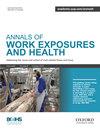85 Elastic-band beard cover for P2/N95 respirators in healthcare workers: an evaluation
IF 1.8
4区 医学
Q3 PUBLIC, ENVIRONMENTAL & OCCUPATIONAL HEALTH
引用次数: 0
Abstract
Disposable P2/N95 respirators are important in preventing nosocomial infections within the healthcare system. Healthcare workers who cannot shave for cultural, religious, or medical reasons, face restrictions in using tight fitted respirators. Alternative solutions, like powered air purifying respirators, do not provide source control and are not universally accepted in healthcare settings, potentially exacerbating staff shortages during periods of high demand. Over the past 18 months, The Royal Melbourne Hospital (RMH) has conducted a comprehensive evaluation of the under-respirator elastic band beard cover, also known as the Singh Thattha Technique. The protocol for implementing and evaluating the technique, has been published in a peer-reviewed open-access journal. Participants are required to pass three fit tests with the elastic band/respirator combination, exceeding standard fit testing practices. The trial results involving the initial 87 participants have also recently been published. Ninety-nine percent of participants successfully passed fit testing with the Industree Trident P2 respirator, while 78% met the protocol criteria using the 3M Aura 1870+. All 87 participants achieved successful fit testing on at least one of these respirators following our stringent protocol. This presentation will explore RMH’s methodology for assessing the elastic band beard cover, examine the test protocol, discuss findings, highlight limitations of the technique, and explore future implications. This work aligns with the conference theme, offering a transformative solution that empowers the healthcare workforce to be prepared for the future.85 医护人员使用 P2/N95 呼吸器的松紧带胡须套:一项评估
一次性 P2/N95 呼吸器对于防止医疗保健系统内的院内感染非常重要。由于文化、宗教或医疗原因而不能剃须的医护人员在使用密闭式呼吸器时会受到限制。动力空气净化呼吸器等替代解决方案无法提供源头控制,在医疗机构中并不被普遍接受,在需求量大的时期可能会加剧人员短缺。在过去的 18 个月里,墨尔本皇家医院(RMH)对呼吸器下的松紧带胡须套(也称为 Singh Thattha 技术)进行了全面评估。实施和评估该技术的方案已发表在同行评审的开放获取期刊上。参与者必须通过三次松紧带/呼吸器组合的密合度测试,这超过了标准的密合度测试惯例。涉及最初 87 名参与者的试验结果也于近期公布。99% 的参与者使用 Industree Trident P2 呼吸器成功通过了密合度测试,78% 的参与者使用 3M Aura 1870+ 呼吸器达到了协议标准。所有 87 名参与者都按照我们严格的协议至少成功通过了其中一种呼吸器的密合度测试。本报告将探讨 RMH 评估松紧带胡须套的方法、检查测试协议、讨论结果、强调该技术的局限性并探讨未来的影响。这项工作与会议主题一致,即提供一种变革性的解决方案,使医疗保健人员能够为未来做好准备。
本文章由计算机程序翻译,如有差异,请以英文原文为准。
求助全文
约1分钟内获得全文
求助全文
来源期刊

Annals Of Work Exposures and Health
Medicine-Public Health, Environmental and Occupational Health
CiteScore
4.60
自引率
19.20%
发文量
79
期刊介绍:
About the Journal
Annals of Work Exposures and Health is dedicated to presenting advances in exposure science supporting the recognition, quantification, and control of exposures at work, and epidemiological studies on their effects on human health and well-being. A key question we apply to submission is, "Is this paper going to help readers better understand, quantify, and control conditions at work that adversely or positively affect health and well-being?"
We are interested in high quality scientific research addressing:
the quantification of work exposures, including chemical, biological, physical, biomechanical, and psychosocial, and the elements of work organization giving rise to such exposures;
the relationship between these exposures and the acute and chronic health consequences for those exposed and their families and communities;
populations at special risk of work-related exposures including women, under-represented minorities, immigrants, and other vulnerable groups such as temporary, contingent and informal sector workers;
the effectiveness of interventions addressing exposure and risk including production technologies, work process engineering, and personal protective systems;
policies and management approaches to reduce risk and improve health and well-being among workers, their families or communities;
methodologies and mechanisms that underlie the quantification and/or control of exposure and risk.
There is heavy pressure on space in the journal, and the above interests mean that we do not usually publish papers that simply report local conditions without generalizable results. We are also unlikely to publish reports on human health and well-being without information on the work exposure characteristics giving rise to the effects. We particularly welcome contributions from scientists based in, or addressing conditions in, developing economies that fall within the above scope.
 求助内容:
求助内容: 应助结果提醒方式:
应助结果提醒方式:


